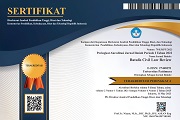Sejarah Perbandingan Sistem Pendaftaran Paten Di Amerika Serikat Dengan Di Indonesia
 ), Erwin Syahruddin(2)
), Erwin Syahruddin(2)
(1) Pascasarjana Ilmu Hukum Universitas Indonesia, Jakarta, Indonesia
(2) Pascasarjana Ilmu Hukum Universitas Indonesia, Jakarta, Indonesia
 Corresponding Author
Corresponding Author
Abstract
Patent protection in a country cannot be separated from the registration system adopted in that country. In the United States the patent registration system is based on the first-to-invent principle. Even though the United States uses the first-to-invent principle, the United States also regulates protection requirements as European countries, Japan and Indonesia are in the form of new discoveries, containing inventive steps, and can be applied in industry. Meanwhile in Indonesia, the patent protection system used is the first to file system, which is a system that grants patent rights to those who first register a new invention in accordance with the requirements. The purpose of this research is to study and analyze the comparative history of the patent registration system in the United States with the patent registration system in Indonesia. The type of research method used is normative legal research with a comparative law approach and a legal history approach. The results of the study found that patent protection in European countries, the United States, Japan and Indonesia has similarities in protection requirements that regulate novelty, inventive steps, and industrial applications.
Keywords
DOI
10.47268/ballrev.v2i1.459
Published
2021-05-31
How To Cite
@article{BALLREV459,
author = {Elisa Sugito and Erwin Syahruddin},
title = {Sejarah Perbandingan Sistem Pendaftaran Paten Di Amerika Serikat Dengan Di Indonesia},
journal = {Batulis Civil Law Review},
volume = {2},
number = {1},
year = {2021},
keywords = {Patent Protection; Patent Registration; Patent System},
abstract = {Patent protection in a country cannot be separated from the registration system adopted in that country. In the United States the patent registration system is based on the first-to-invent principle. Even though the United States uses the first-to-invent principle, the United States also regulates protection requirements as European countries, Japan and Indonesia are in the form of new discoveries, containing inventive steps, and can be applied in industry. Meanwhile in Indonesia, the patent protection system used is the first to file system, which is a system that grants patent rights to those who first register a new invention in accordance with the requirements. The purpose of this research is to study and analyze the comparative history of the patent registration system in the United States with the patent registration system in Indonesia. The type of research method used is normative legal research with a comparative law approach and a legal history approach. The results of the study found that patent protection in European countries, the United States, Japan and Indonesia has similarities in protection requirements that regulate novelty, inventive steps, and industrial applications.},
issn = {2746-8151}, pages = {16--23} doi = {10.47268/ballrev.v2i1.459},
url = {https://fhukum.unpatti.ac.id/jurnal/ballrev/article/view/459}
}
Djumhana, M., & Djubaedillah, R. (2009). Hak Milik Intelektual, Sejarah, Teori dan Prakteknya di Indonesia. Citra Aditya Bakti.
Foster, F. H., & Shook, R. L. (1993). Patents,Copyrights & Trademarks. John Wiley & Sons Inc.
Gautama, S., & Winata, R. (1998). Pembaharuan Undang-Undang Paten 1997. Citra Aditya Bakti.
Glendon, M. A., Gordon, M. W., & Carozza, P. G. (2016). Comparative Legal Traditions : In A Nutshell. West Academic Publishing.
Hadiarianti, V. S. (2015). Memahami Hukum Atas Karya Intelektual. UNIKA ATMAJAYA.
Japan Patent Office. (2001). Comparative Study on the Japanese, the United States and the European Patent Systems (JIII; Asia-Pacific Industrial Property Center).
Kaufer, E. (1989). The Economics of the Patent System. Harwood Academic Publisher.
Labetubun, Muchtar A H, & Fataruba, S. (2016). Peralihan Hak Cipta Kepada Ahli Waris Menurut Hukum Perdata. SASI, 22(2), 1-11. https://fhukum.unpatti.ac.id/jurnal/sasi/article/view/163
Labetubun, Muchtar Anshary Hamid. (2018). Aspek Hukum Hak Cipta Terhadap Buku Elektronik (E-Book) Sebagai Karya Kekayaan Intelektual. SASI, 24(2), 138-149. https://doi.org/10.47268/sasi.v24i2.128
https://doi.org/10.47268/sasi.v24i2.128
Mamudji, S., Rahardjo, H., Supriyanto, A., Erny, D., & Pudji Simatupang, D. (2005). Metode Penelitian dan Penulisan Hukum. Badan Penerbit Fakultas Hukum Universitas Indonesia.
Marzuki, P. M. (2000). Luasnya Perlindungan Paten, dalam Kapita Selekta Hak Kekayaan Intelektual I. Pusat Studi Hukum UII Yogyakarta Bekerja Sama dengan Yayasan Klinik HAKI Jakarta.
Maulana, I. B. (1999). Penerapan Paten Sejak UU Paten No. 6 Tahun 1989 Hingga UU Paten No. 13 Tahun 1997: Pengalaman Indonesia Selama Ini. Jurnal Hukum Ius Quia Iustum, 6(12), 1-16. https://doi.org/10.20885/iustum.vol6.iss12.art1
https://doi.org/10.20885/iustum.vol6.iss12.art1
Mossof, A. (2001). Rethinking the Development of Patents: An Intellectual History 1550-1800. Hastings Law Journal, 52(6), 1255-1322. https://repository.uchastings.edu/hastings_law_journal/vol52/iss6/2/
Yodo, S. (2016). Perlindungan Hak Paten (Studi Komparatif Lingkup Perlindungandi Beragai Negara). FIAT JUSTISIA:Jurnal Ilmu Hukum, 10(4), 587-814. https://doi.org/10.25041/fiatjustisia.v10no4.821
Cited-By:
1. IJALS SYMPOSIUM ON TECHNOLOGICAL ADVANCEMENT FOR SOCIAL WELFARE: Technological Advancement for Social Welfare: Contemporary Development and the Future Impact
Waspiah Waspiah, Budi Santoso, Paramita Prananingtyas, Januari Nasya Ayu Taduri, Ridwan Arifin
Paper Title: Technological advancement on patent registration in Indonesia
first page: 030023 year: 2022
Type: Book [View Source]
2. Legal Safeguards for Owners of Untapped Foreign Brands Under Indonesia's First-to-File Principle
Arfiansyah Dewa Artija, Sri Budi Purwaningsih
Indonesian Journal of Law and Economics Review vol: 19 issue: 2 year: 2024
Type: Journal [View Source]
| Dublin Core | PKP Metadata Items | Metadata for this Document | |
| 1. | Title | Title of document | Sejarah Perbandingan Sistem Pendaftaran Paten Di Amerika Serikat Dengan Di Indonesia |
| 2. | Creator | Author's name, affiliation, country | Elisa Sugito; Pascasarjana Ilmu Hukum Universitas Indonesia, Jakarta; Indonesia |
| 2. | Creator | Author's name, affiliation, country | Erwin Syahruddin; Pascasarjana Ilmu Hukum Universitas Indonesia, Jakarta; Indonesia |
| 3. | Subject | Discipline(s) | |
| 3. | Subject | Keyword(s) | Patent Protection; Patent Registration; Patent System |
| 4. | Description | Abstract | Patent protection in a country cannot be separated from the registration system adopted in that country. In the United States the patent registration system is based on the first-to-invent principle. Even though the United States uses the first-to-invent principle, the United States also regulates protection requirements as European countries, Japan and Indonesia are in the form of new discoveries, containing inventive steps, and can be applied in industry. Meanwhile in Indonesia, the patent protection system used is the first to file system, which is a system that grants patent rights to those who first register a new invention in accordance with the requirements. The purpose of this research is to study and analyze the comparative history of the patent registration system in the United States with the patent registration system in Indonesia. The type of research method used is normative legal research with a comparative law approach and a legal history approach. The results of the study found that patent protection in European countries, the United States, Japan and Indonesia has similarities in protection requirements that regulate novelty, inventive steps, and industrial applications. |
| 5. | Publisher | Organizing agency, location | Faculty of Law, Universitas Pattimura |
| 6. | Contributor | Sponsor(s) | |
| 7. | Date | (YYYY-MM-DD) | 2021-05-31 |
| 8. | Type | Status & genre | Peer-reviewed Article |
| 8. | Type | Type | |
| 9. | Format | File format | |
| 10. | Identifier | Uniform Resource Identifier | https://fhukum.unpatti.ac.id/jurnal/ballrev/article/view/459 |
| 10. | Identifier | Digital Object Identifier | 10.47268/ballrev.v2i1.459 |
| 11. | Source | Title; vol., no. (year) | Batulis Civil Law Review; Vol 2, No 1 (2021): VOLUME 2 NOMOR 1, MEI 2021 |
| 12. | Language | English=en | en |
| 13. | Relation | Supp. Files | |
| 14. | Coverage | Geo-spatial location, chronological period, research sample (gender, age, etc.) | |
| 15. | Rights | Copyright and permissions | Copyright: Authors who publish their manuscripts in this Journal agree to the following conditions: 1. The copyright in each article belongs to the author, as well as the right to patent. 2. Authors are able to enter into separate, additional contractual arrangements for the non-exclusive distribution of the journal's published version of the work (e.g., post it to an institutional repository or publish it in a book), with an acknowledgment of its initial publication in this journal. 3. Authors are permitted and encouraged to post their work online (e.g., in institutional repositories or on their website) prior to and during the submission process, as it can lead to productive exchanges, as well as earlier and greater citation of published work. 4. Authors have the right to self-archiving of the article (Author Self-Archiving Policy)
Licence : Batulis Civil Law Review Journal is disseminated based on the Creative Commons Attribution-NonCommercial 4.0 International license terms. This license allows anyone to copy and redistribute this material in any form or format, compose, modify, and make derivatives of this material for any purpose. You cannot use this material for commercial purposes. You must specify an appropriate name, include a link to the license, and certify that any changes have been made. You can do this in a way that is appropriate, but does not imply that the licensor supports you or your use.
|
Copyright (c) 2021 Elisa Sugito, Erwin Syahruddin

This work is licensed under a Creative Commons Attribution-NonCommercial 4.0 International License.
Cited-By:
1. IJALS SYMPOSIUM ON TECHNOLOGICAL ADVANCEMENT FOR SOCIAL WELFARE: Technological Advancement for Social Welfare: Contemporary Development and the Future Impact
Waspiah Waspiah, Budi Santoso, Paramita Prananingtyas, Januari Nasya Ayu Taduri, Ridwan Arifin
Paper Title: Technological advancement on patent registration in Indonesia
first page: 030023 year: 2022
Type: Book [View Source]
2. Legal Safeguards for Owners of Untapped Foreign Brands Under Indonesia's First-to-File Principle
Arfiansyah Dewa Artija, Sri Budi Purwaningsih
Indonesian Journal of Law and Economics Review vol: 19 issue: 2 year: 2024
Type: Journal [View Source]

 : 9345 times
: 9345 times Download : 3988 times
Download : 3988 times














